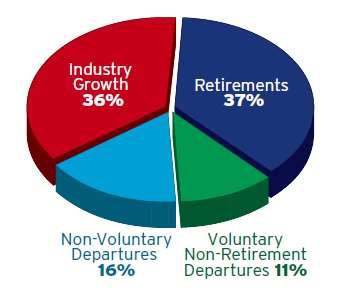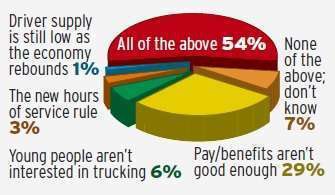Part 1 in this series, “Countdown to a capacity crunch, and a boost in rates?”, looked at data showing a disconnect between capacity and driver demand. Find it here.
 FUELING DRIVER DEMAND | These key factors are creating a demand for nearly 100,000 new drivers each year over the coming decade as experienced drivers reach retirement age and trucking continues to grow, says the American Trucking Associations.
FUELING DRIVER DEMAND | These key factors are creating a demand for nearly 100,000 new drivers each year over the coming decade as experienced drivers reach retirement age and trucking continues to grow, says the American Trucking Associations.The last capacity crunch, roughly 2004-08, is considered to have been a great time for the industry by some participants.
Steve Williams, chief executive officer of Maverick USA, looks no further than his bottom line to know that the balance of transportation supply and demand again has shifted in favor of carriers, even if it’s not a repeat of 2004.
“The capacity shortage is very real,” says Williams, a former chairman of the American Trucking Associations. “But now I’ve got more business than I have drivers. The name of the game from here on out is recruiting, training and retention.”
Why do so many carriers continue to experience difficulty finding new drivers?
Among the 1,344 respondents to the above OverdriveOnline.com poll, more than 100 readers submitted comments, including these: Wade: Carriers with solid business models and management are not struggling to find drivers. Carriers with weak business models and weak management teams make excuses instead of positive changes. JW: If they are going to be regulating by the hour, then they need to begin paying by the hour … multiplied by 70 to 80 hours a week. I am finally getting back into trucking after a four-year leave and can honestly say it is out of control. I was a fuel desk cashier for the past six months, and it amazed me the quality of drivers being hired these days! Jrs2slow: If you got into trucking and thought you were only going to work 40 or even 50 hours a week, it’s time to think again. And after 27 years of driving both OTR and local and seeing what is happening with drivers and companies, I knew it was only a matter of time before the government dropped the boom on everyone, and that is what they have done. Bob Moore: [The driver shortage] is due to FMCSA changing the rules (HOS) without knowing much about trucking. Our pay rates not increasing much over the years doesn’t help much. Also, companies treating drivers like we are a dime a dozen has caused a lot of the problems. Lowridin Truck Drivin: I think a lot of it has to do with these “starter companies.” While they’re great at helping new drivers get a start, they’re like puppy mills, churning out drivers with no plan for retention. That’s why most new drivers don’t make it past six months with their first company. They feel abused and left hung out to dry. Fred Flintstone AKA Big Al P: First off, the trainers are not from the OLD SCHOOL and have no idea what makes a Professional Truck Driver. Today we have Steering Wheel Holders! Trainers are not from the old school where we had time to help one another. Martymarsh: I worked for a guy that had seven trucks, and he said that there is only one secret to keeping drivers: Tell them what you are going to pay them, and then pay them. In the three years I was there, he didn’t need to hire any drivers. I would still be there if he hadn’t sold the business. |
Maverick, a longtime flatbed carrier that has expanded by adding specialized glass and refrigerated divisions, is “almost back” to its pre-recession seated truck count.
Williams calls 2012’s turnover “normal” at 58 percent, which is well below the industry average for large truckload carriers – typically about 100 percent. Maverick also grew by 250 trucks, its best total for a year without an acquisition. Along with financial and safety performances that were “stellar,” the year was the company’s best ever for recruiting, he says.

By this summer, the fleet was reduced by 105 trucks, while turnover was up slightly. However, recruiting statistics are “unbelievably different,” as Williams details.
Year-to-date in 2012: 16,316 leads processed, with 674 drivers hired; YTD 2013: 30,210 leads – or nearly double 2012’s to-date total – yet only 559 hires, or 115 fewer.
“Frequency is up,” he says. “More leads and more apps, but we’re rejecting an unprecedented number for one reason or another.”
Williams points out that Maverick is particularly cautious in its hires: The process includes hair follicle testing and sleep apnea screening. But Williams and Maverick have long advocated strict driver qualifications: Now other carriers must think twice, in the CSA environment, about looking the other way when it comes to new hires with spotty driving records.
“It’s time to continue to make it difficult to get in this industry and stay in this industry,” he says. “If you can’t cut it, get out.”
Given that the economy has not been robust, Williams says the growing supply/demand imbalance is capacity-driven.
“When we have little spot surges, like we’ve had in building materials, there are no trucks to haul it,” he says. But a sustained shortage of equipment – one that will allow carriers to set consistently higher prices – has yet to emerge.
“There’s a solution – pay drivers more money,” Williams says. “That attracts better talent. But you can’t have just one shipper that sees the light and gives you more money. You’ve got to have all the shippers see the light so you can raise your rates across all your lanes.”
Plan B: No experience required
For many carriers, a new driver is preferable to an experienced driver with bad habits, especially one with the bad driving history to prove it.
Lou Spoonhour, president of DriveCo and a former chairman of the Commercial Vehicle Training Association, says it’s about time for such a shift.
“I’ve been at this for 34 years, and we’re hearing from trucking companies that I’ve never heard the names of before,” Spoonhour says. “All of a sudden, entry-level is opening up as if it’s a brand-new field.”
“There’s a solution – pay drivers more money…. That attracts better talent. But you can’t have just one shipper that sees the light and gives you more money.” –Maverick’s Steve Williams on difficulty raising rates
Most CVTA schools also have regular, direct contact with carrier safety departments to stay up to date with hiring criteria.
“Sometimes the experienced driver is set in his ways, whereas a student is a clean slate and can be molded,” Spoonhour says. “That’s what we claim to be our advantage – they’re coming out with no extra baggage.” Typically, driving school graduates will go on to a carrier’s finishing school for more advanced training.
The average student age is “probably 35 to 40, where it used to be 28 to 33,” Spoonhour said. “We’ve started to get an increase in skilled workers, like electricians, carpenters, plumbers who made a living in the construction trades. We’ve found that trucking is a good option for ‘hands-on’ people. Or they have friends or relatives who drive.”
Students also see truck driving as a lasting opportunity that won’t be shipped overseas, Spoonhour says.
In order to maintain a 95 percent placement rate for its 200 to 300 students each year, DriveCo screens extensively. Students have to be able to pass a physical and a drug screen, and they’re subject to random drug tests while in school. Additionally, the school checks the prospective student’s driving record and criminal history. Pre-enrollment interviews are designed to make sure the students understand trucking and that the business will be a good fit with their personal goals.
Stay tuned for the Wednesday, Sept. 4, final installment in the series, with four driving veterans’ views on who’s taking the wheel today.














